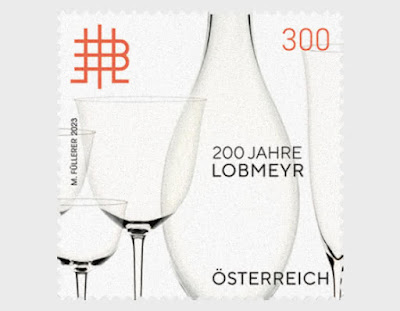2796) J.&L. Lobmeyr, Republic of Austria: 200 Year Anniversary (1823-2023): Österreichische Post (Austrian Post) has issued a postage stamp celebrating the milestone: Date of Stamp issue: 20.04.2023:
J.&. L. Lobmeyr is a glassware company from Vienna, Austria. It was founded in 1823 by Josef Lobmeyr and is still family owned.
When his children acquired the company they renamed it J. & L. Lobmeyr, named after his son Joseph and brother Louis.
Josef became the marketing director and Louis managed the art department. Josef's son Ludwig Lobmeyr developed further professional relationships with Bohemian glassworks and glass making companies and co-founded the Museum of Applied Arts in 1864 and also created numerous classical designs himself.
At the turn of the century, artists from the Vienna Workshop collective designed numerous pieces for Lobmeyr.
They had an office at Kamenický Šenov and partners included Wilhelm Kralik of Meyrswalden.
J. & L. Lobmeyr provided a crystal chandelier for Schönbrunn Palace and other clients. They also had a partnership with Thomas Edison. They co-developed the first electric chandeliers in the world, in 1880, with Edison.
They provided services for the King of Belgium, the Duke of Brabant, and the Court of Flanders.
In 1906 they opened an office in Karlovy Vary. Around this time, clients included Archduke Franz Ferdinand of Austria. In recognition of their services, they were titled purveyor to the Imperial Court. Additional clients included the Vienna State Opera, the Metropolitan Opera, the John F. Kennedy Center for the Performing Arts, and the Kremlin.
In 1917, Louis passed away and the company was left to Stefan Rath (1876-1960), Louis' nephew. Presently, the company is still owned by Rath's grandchildren Andreas, Leonid and Johannes.
The company is now run by the sixth generation of the family.
About 200 Year Anniversary of Lobmeyr:
For 200 years, the Lobmeyr family business in Vienna has been producing glass products of unsurpassed quality.
Presently, Lobmeyr designs exclusive lighting concepts in various styles and produces high-quality mirrors and hand-blown, hand-cut glass series, drinking glasses, vases, and accessories. The company pairs tradition and craftsmanship with technical innovation and internationally renowned design.
Lobmeyr Glass:
The technique of melting quartz sand and forming durable cultural objects from it dates back to the fourth millennium BC.
Glass has always fascinated. With its transparency, its unique shine and its play with light and reflection, it has properties that only diamond, and rock crystal have.
This fascination for glass has been driving Lobmeyr for two hundred years now.
Over six generations, the peculiarities of the material have been researched in-house and its processing and design possibilities have been explored.
Lighting Concepts:
Based on an individual consultation, the company creates tailor-made concepts for our customers for the conditions on site. Great importance is attached to sustainability. This includes maintenance-friendly and thus customer-friendly operation of the lighting fixtures as well as their technical and aesthetic longevity.
Chandelier Craft:
Lobmeyr also makes a conscious decision when it comes to chandeliers. Each individual piece is made by a craftsman from start to finish.
Traditional craftsmanship and a rich archive has enabled the authentic production of chandeliers of any style and are an inexhaustible source of inspiration.
Old techniques such as the hammering of the "Nockerl profile" for baroque chandeliers and the "edge" of fine ornaments are still used today. Lobermyr has curtain shapes for almost all chandelier styles, custom-made products are not uncommon.
Muslin Glass – the highlight of the glassmaker
Named after the light textile "muslin", it is a glass to a thickness of only 0.7 to 1.1 mm blown. The drinking glass creates a very delicate The rim of the mouth and thus an incomparably fine contact between mouth, glass and drink.
Even an excellent glassblower needs many years of experience in the production of muslin glass. Since the glowing melt solidifies in a very short time, work must be carried out quickly and decisively. Anyone who has ever watched glassmakers do this will be amazed at their speed and virtuosity. The precision with which similar series are formed by hand is also astonishing – and yet the preciousness of the handmade glass lies in the minimal irregularities. Muslin glass seems fragile, but thanks to its internal Elasticity and formal construction great resistance.
Each Lobmeyr glass is first blown into wet wooden molds, the escaping vapor forms a buffer between the wooden mold and the glass and is also responsible for the incomparable shine of the finished piece. The stem and bottom are attached freehand by the master. After careful cooling, the glass bubble is cut off at the level of the edge of the mouth, the edge is sanded and polished.
Until it is sold, a Lobmeyr glass/jar goes through at least 24 hands and four quality controls, the last always by a family member.
The Stamp:
The stamp motif shows a muslin glass service by Josef Hoffmann from 1917.
The postage stamp
Posts on Grimm's Fairy Tales on this Blog:
More posts on insect world on this blog:
i) Beetles: A set of five Post Cards issued by Chennai Postal Circle of India Post in 2017
ii) Lady Bug Beetles: A set of four Commemorative stamps brought out by India Post on 23.02.2017
Posts on "Wonderful World of Insects":
Links: Crypto-Currency Stamps & Coin Posts:
Related Links on this Blog:

Santosh Khanna has commented:
ReplyDelete"Thanks for sharing this informative and interesting post."
Thank you so much, Khanna sahab.
Delete